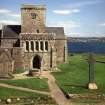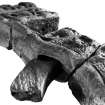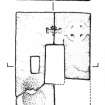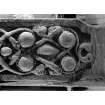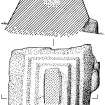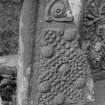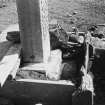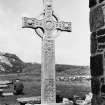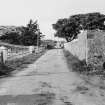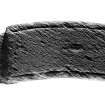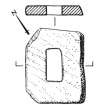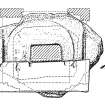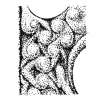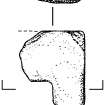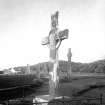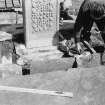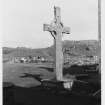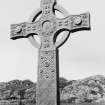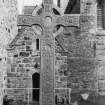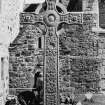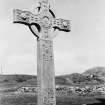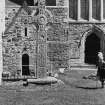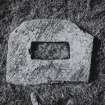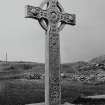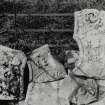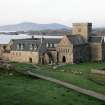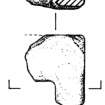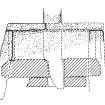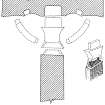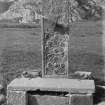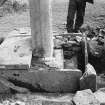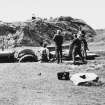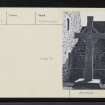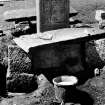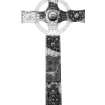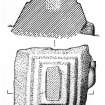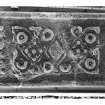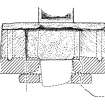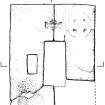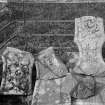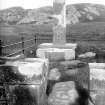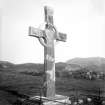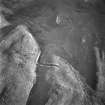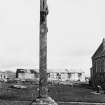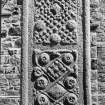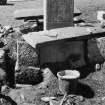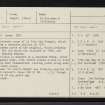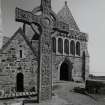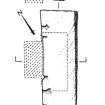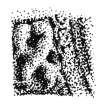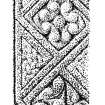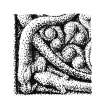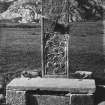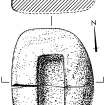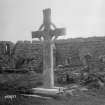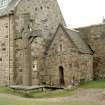Scheduled Maintenance
Please be advised that this website will undergo scheduled maintenance on the following dates: •
Tuesday 12th November from 11:00-15:00 & Thursday 14th November from 11:00-15:00
During these times, some services may be temporarily unavailable. We apologise for any inconvenience this may cause.
Iona, St John's Cross
Cross (Early Medieval)
Site Name Iona, St John's Cross
Classification Cross (Early Medieval)
Canmore ID 21654
Site Number NM22SE 4.05
NGR NM 28651 24508
Datum OSGB36 - NGR
Permalink http://canmore.org.uk/site/21654
First 100 images shown. See the Collections panel (below) for a link to all digital images.
- Council Argyll And Bute
- Parish Kilfinichen And Kilvickeon
- Former Region Strathclyde
- Former District Argyll And Bute
- Former County Argyll
NM22SE 4.5 28651 24508.
(NM 2865 2450) Cross (NR)
OS 25" map (1900)
The restored cross of St John the Evangel, which was replaced by a concrete replica in 1970. The broken parts of the original, which probably dated from c.800 and which was restored in 1926, are housed in the Nunnery Museum.
The replica is mounted on a concrete block, about which the original base, with corner stones worked to hold side slabs, has been reassembled, missing parts being made good with suitable stone.
The name "St John's Cross" was formerly applied to what is now St Mathew's Cross (NM22SE 4.4), though neither name is of any great age.
J J Waddell 1941; J Morrison 1953; J R Allen 1901; R Reece, undated
Site is for the replica of St John's Cross. For original fragments see NM22SE 4 05 and NM22SE 5 01.
Field Visit (9 June 1972)
As described.
Visited by OS (RD) 9 June 1972
Field Visit (September 1980)
St John's Cross.
This ringed cross originally stood within a box-like base some 4·8m w of the small chapel known as 'St Columba's Shrine' and 1l·6m NW of the w door of the abbey church. The broken cross-shaft was recorded in 1699 by Lhuyd in drawings which show that already only the three lower ornamental panels of the W face remained intact, and that part of the second panel of the E face had flaked off. Further damage to the upper part of the w face occurred between 1859 and 1874, but the surface flakes from both faces were preserved. Various fragments of the cross-head, and part of the upper panel of the shaft, possibly discovered during the clearance operations of 1874-6, were displayed for some years within the railed enclosures in Reilig Odhráin, and in about 1900 were moved into St Oran's Chapel. The form of the crosshead was first reconstructed by J Romilly Alien, who however did not associate it with the shaft. This identification was first suggested by R A S Macalister, under whose supervision the cross-head was re-united with its shaft in 1927, the missing portions being made good with concrete. The upper part of the cross was blown down during a gale in 1951 and, following its re-erection three years later, fell again in 1957. Thereafter it was decided to replace the original cross by a pre-stressed concrete reproduction, which was installed in the cross-base in 1970. At the date when this volume went to press, the fragments of the original cross were in the custody of the Ancient Monuments Branch of the Scottish Development Department, undergoing conservation for subsequent return to Iona to be exhibited in a sheltered setting.
The existence of a cross named after St John was first mentioned by Dr Johnson in 1773, but without sufficient detail for it to be certain which one was so described . In its fragmentary state it attracted little notice from visitors, and during the 19th century the name was applied by some writers to the cross now known as 'St Matthew's', the first unambiguous use of the name perhaps being that by Skene in 1875. Despite this confusion, however, it is possible that the cross, whose Gaelic name Cros Eoin survived in local tradition, preserved its ancient dedication. Certainly its ambitious scale and elaborate ornament would be consistent with the special veneration for the evangelist John and his gospel in the early Irish and Northumbrian churches.
It is suggested on pp. 17-19 that St John's Cross, which has the widest span of any known cross of Early Christian date in the British Isles, was carved about the middle or in the second half of the 8th century, and that the ringed cross-head may have been developed in the course of the repairs made necessary by its presumed fall.
See RCAHMS 1982 pp.197-204 for a detailed and illustrated description.
RCAHMS 1982, visited September 1980
Reference (2001)
(Iona 82) ST JOHN'S CROSS. Abbey Museum, W end, and ring-fragment in store. This ringed cross stood in a composite base (no.96) W of 'St Columba's Shrine', where the broken shaft was drawn by Lhuyd in 1699. The name was first recorded by Johnson in 1773, but may be ancient. Fragments of the head were identified by H D Graham but neither he nor J Romilly Allen associated it with the shaft. The cross was reconstructed in situ by R A S Macalister in 1927, but fell in 1951 and again in 1957. A concrete replica was installed in the original base in 1970, and following conservation the cross was returned to Iona in 1990.
The cross, which was composed of four main sections and four ring-quadrants all linked by mortice-and-tenon joints, measured about 5.3m by 2.17m in span. The arms are double-curved, with slightly concave ends and 0.52m semicircular armpits, and the ring is 1.25m in diameter. The shaft and the upper arms are of greenish chlorite-schist, probably from the Loch Sween area, but the finial of the top arm and the only surviving ring-fragment are of silver-grey mica-schist from the Ross of Mull. This discrepancy, with damage on the butt and the awkward relation of stone-joints to ornament, suggest that the cross was originally ringless with a single joint at the centre of the head. Following an early fall, the ring-quadrants were introduced to stabilise the head, and local stone was used to replace damaged areas in the top arm and the now-lost lower arm.
Both faces are framed by half-round mouldings, and on the W face of the shaft inner borders of fine-line interlace enclose the three lower panels of ornament. A fourth panel, and the three larger ones on the E face, resemble the cross-head in having no inner margin. The dominant ornament is spiral-work linking bird's-nest and other bosses of varying size, including the cruciform groupings with saltire infilling seen on St Oran's Cross. In the lowest panel of the E face this motif is combined with two roundels formed by snakes, some with fierce biting jaws attacking others with lizard-like forequarters. Other forms of snake-and-boss ornament are seen on both faces of the shaft and arms. The lowest panel on the W face is a rich cruciform design, and the central shaft-panel of the E face is a low-relief diaper with interlace and key-patterns. At the centre of the E face of the cross-head is a 0.31m boss covered in interlace, within a circle of spiral-linked bosses, and in the W face is a shallow 0.28m recess, perhaps designed for a metal boss, in a circle of spiral roundels. The arms and the top E shaft-panel also contain prominent bosses, some of bird's-nest type, placed centrally in their panels rather than on the line of the ring, but in the W shaft-panel there is a 0.19m recess like that above. The constrictions of the arms are filled with interlace in which are grouped small zoomorphic figures. Above the end-moulding of the top arm is a damaged finial which on the E face shows two confronted beasts and on the W face appears to include two wrestling figures.
(96) Until 1957 the shaft of St John's Cross (no.82) stood in a complex box-like base with four corner-posts linked by side-slabs and supporting a composite cover-slab, and two concealed socket-stones. A new W cover-slab was added in 1970 to support the replica cross, and new side-slabs were fitted between the corner-posts. The two socket-stones were removed to the Nunnery. The upper of them is an irregular slab, 1.97m by 1.44m and 0.25m thick, with a 1.15m incised circle on the upper face, perhaps for intended use as a millstone. A notch housed the SW corner-post and grooves were cut for the lower edges of the side-slabs. The central socket measures 0.49m by 0.24m. The rectangular lower socket-stone measures 1.07m by 0.84m by 0.15m, and the socket measures 0.48m by 0.23m. The corner-posts, which are about 1m in height, were grooved and rebated to receive the lost side-slabs. The original E cover-slab, 1.55m by 0.54m, butted against the cross-shaft, which occupied a rebate cut into the lost W slab. The two were held together by metal cramps whose shallow recesses are visible.
I Fisher 2001.
Note (12 June 2017 - 31 July 2017)
NM 28648 24508 – Iona Abbey/St John’s Cross replica – This is one of the first qualitative social studies examining how replicas of historic objects and monuments ‘work’ (8th century AD to present). It aims to advance recent interdisciplinary debates about the relationship between original historic monuments and replicas, as well as inform the use of replicas at heritage sites. Nearing its 50th anniversary, our study centres on the St John’s Cross erected in front of Iona Abbey in 1970, arguably the most iconic of Iona’s monuments.
Replicas are routinely used at heritage sites and museums, although their value is much debated. Authenticity has long been associated with original historic objects and considerable emphasis is placed on the distinct, secondary status of replicas. Yet replicas remain unruly objects, potentially
subverting or appropriating the authenticity and value of originals. This project examines the forms of meaning, value and authenticity associated with replicas using focused ethnographic methods, concentrating on the early Christian carved stones at Iona, where originals and replicas co-exist
in museum and landscape contexts. Engaging with key communities of interest, the research will shed new light on how replicas mediate
people’s relationships with the past.
The results of the project will advance recent interdisciplinary debates, and have important implications regarding when and how replicas are used. Our fieldwork methods were: semi-structured recorded interviews with people who live and/or work on Iona, short- and long-stay residents, tourists, heritage professionals and others with an interest in the replica; participant observation (spending time in a place and observing daily activities); undertaking a community digital workshop with local volunteers to produce a 3D model of the St John’s Cross replica and other monuments on Iona. We are also undertaking archival research to create a cultural biography of the St John’s Cross (its life from the 8th century to today).
Funder: Royal Society of Edinburgh and Historic Environment Scotland
Website: https://www.stir.ac.uk/cehp/projects/concreteandnonconcrete/
Sally Foster, Siân Jones and Stuart Jeffrey – University of Stirling
(Source: DES, Volume 18)










































































































